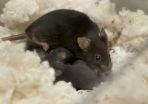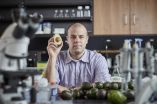(Press-News.org) A strain of bacteria that "breathes" uranium may hold the key to cleaning up polluted groundwater at sites where uranium ore was processed to make nuclear weapons.
A team of Rutgers University scientists and collaborators discovered the bacteria in soil at an old uranium ore mill in Rifle, Colorado, almost 200 miles west of Denver. The site is one of nine such mills in Colorado used during the heyday of nuclear weapons production.
The research is part of a U.S. Department of Energy program to see if microorganisms can lock up uranium that leached into the soil years ago and now makes well water in the area unsafe to drink.
The team's discovery, published in the April 13, 2015 issue of PLOS ONE, is the first known instance where scientists have found a bacterium from a common class known as betaproteobacteria that breathes uranium. This bacterium can breathe either oxygen or uranium to drive the chemical reactions that provide life-giving energy.
"After the newly discovered bacteria interact with uranium compounds in water, the uranium becomes immobile," said Lee Kerkhof, a professor of marine and coastal sciences in the School of Environmental and Biological Sciences. "It is no longer dissolved in the groundwater and therefore can't contaminate drinking water brought to the surface."
Kerkhof leads the Rutgers team that works with U.S. Department of Energy researchers.
Breathing uranium is rather rare in the microbial world. Most examples of bacteria which can respire uranium cannot breathe oxygen but often breathe compounds based on metals - typically forms of solid iron. Scientists had previously witnessed decreasing concentrations of uranium in groundwater when iron-breathing bacteria were active, but they have yet to show that those iron-breathing bacteria were directly respiring the uranium.
While the chemical reaction that the bacteria perform on uranium is a common process known as "reduction," or the act of accepting electrons, Kerkhof said it's still a mystery how the reduced uranium produced by this microorganism ultimately behaves in the subsurface environment.
"It appears that they form uranium nanoparticles," he said, but the mineralogy is still not well known and will be the subject of ongoing research.
The Rutgers team was able to isolate the uranium-breathing bacterium in the lab by recognizing that uranium in samples from the Rifle site could be toxic to microorganisms as well as humans. The researchers looked for signs of bacterial activity when they gradually added small amounts of dissolved uranium at the right concentration back to the samples where uranium had become immobilized. Once they found the optimal uranium concentrations, they were able to isolate the novel strain.
Exactly how the strain evolved, Kerkhof said, "we are not sure." But, he explained, bacteria have the ability to pass genes to each other. So just like bacteria pick up resistance to things like antibiotics and heavy metal toxicity, this bacterium "picked up a genetic element that's now allowing it to detoxify uranium, to actually grow on uranium." His research team has completed sequencing its genome to support future research into the genetic elements that allow the bacterium to grow on uranium.
What Kerkhof is optimistic about is the potential for these bacteria to mitigate the specific groundwater pollution problem in Rifle. Scientists at first expected the groundwater to flush into the Colorado River and carry the dissolved uranium with it, where it would get diluted to safer levels. But that hasn't happened. Other potential methods of remediation, such as digging up the contaminated soil or treating it with harsh chemicals, are thought to be too expensive or hazardous.
"Biology is a way to solve this contamination problem, especially in situations like this where the radionuclides are highly diluted but still present at levels deemed hazardous," said Kerkhof. If the approach is successful, it could be considered for other sites where uranium was processed for nuclear arsenals or power plant fuel. While the problem isn't widespread, he said there's potentially a lot of water to be concerned about. And the problem could spread beyond traditional places such as ore processing sites.
"There is depleted uranium in a lot of armor-piercing munitions," he said, "so places like the Middle East that are experiencing war could be exposed to high levels of uranium in the groundwater."
INFORMATION:
Zinc plays an important role in a woman's ability to successfully breast-feed her child, according to health researchers.
It has long been known that zinc, an essential trace element, is passed to infants through mother's breast milk. The levels of zinc in mother's milk and the effects of zinc deficiency in infants have been previously studied, but the role of zinc in breast development and function in lactating mothers is a relatively new area of research.
The protein ZnT2 transports zinc in specific tissues in the body, including the mammary glands. Shannon L. Kelleher ...
This news release is available in German. ETH material engineers found that the performance of ion-conducting ceramic membranes that are so important in industry depends largely on their strain and buckling profiles. For the first time, scientists can now selectively manipulate the buckling profile, and thus the physical properties, allowing new technical applications of these membranes.
"Ionics, ion-based data processing and energy conversion, is the electronics of the future", says Jennifer Rupp, a professor of Electrochemical Materials at ETH Zurich, and therewith ...
WASHINGTON, D.C. - The high seas of Mars may never have existed, according to a new study that looks at two opposite climate scenarios of early Mars and suggests that a cold and icy planet billions of years ago better explains water drainage and erosion features seen on the planet today.
For decades, researchers have debated the climate history of Mars and how the planet's early climate led to the many water-carved channels seen today. The idea that 3 to 4 billion years ago Mars was once warm, wet and Earth-like with a northern sea -- conditions that could have led ...
Researchers who paired Siamese fighting fish in mock fights found that winning fish could supply more energy to their muscles during fights than losing fish.
The findings link the invisible processes going on inside cells to tangible consequences in the visible world, and they show how a behavior such as aggression can be affected by underlying biochemical processes that help sustain an animal's life.
"Conspicuous adaptations like antlers are usually what come to mind when thinking about traits that maximize success in aggressive interactions, but as these interactions ...
Rich, creamy, nutritious and now cancer fighting. New research reveals that molecules derived from avocados could be effective in treating a form of cancer.
Professor Paul Spagnuolo from the University of Waterloo has discovered a lipid in avocados that combats acute myeloid leukemia (AML) by targeting the root of the disease - leukemia stem cells. Worldwide, there are few drug treatments available to patients that target leukemia stem cells.
AML is a devastating disease and proves fatal within five years for 90 per cent of seniors over age 65. Spagnuolo's new avocado-derived ...
The world's first study into the brain anatomy of a marine reptile that lived at the same time as the dinosaurs sheds light on how the reptilian brain adapted to life in the oceans.
The fossils of ichthyosaurs, which lived 150 to 200 million years ago, are often very well preserved, but they are commonly flattened. Now investigators have used computed tomography to create a 3-D scan of the animal's skull, revealing internal details of the palate and braincase that usually cannot be seen. A reconstruction of the brain shows the importance of vision for the predator, which ...
In a new study, older women who lived in places with higher air pollution had significantly reduced white matter in the brain. For the study, a research team took brain MRIs of 1403 women who were 71 to 89 years old and used residential histories and air monitoring data to estimate their exposure to air pollution in the previous 6 to 7 years.
The findings suggest that ambient particulate air pollutants may have a deleterious effect on brain aging.
"Investigating the impact of air pollution on the human brain is a new area of environmental neurosciences. Our study provides ...
The prevalence of smoking among undergraduate nursing and physiotherapy students in Spain decreased from 29.3% in 2003 to 18.2% in 2013. Many of the students remained unaware of the link between smoking and diseases such as bladder cancer or the negative health effects of second-hand smoke, which points to a significant deficiency in undergraduate training.
The majority of nursing and physiotherapy students recognized that healthcare professionals were role models in society, noted Dr. Beatriz Ordás, lead author of the Journal of Advanced Nursing study.
INFORMATION: ...
Following a decade of steady growth, use of bisphosphonates--medications that are effective for treating osteoporosis--declined in the United States by more than 50% from 2008 to 2012.
The sudden drop seemed to occur after media reports highlighted safety concerns, such as the development of certain fractures that occurred rarely in long-term users, despite the fact that the US Food and Drug Administration and the American Society of Bone and Mineral Research did not recommend any specific safety restrictions on bisphosphonates. The findings are published in the Journal ...
A new study shows that shorter telomeres--which are the protective caps at the end of a cell's chromosomes--are linked with worse survival in a progressive respiratory disease called idiopathic pulmonary fibrosis (IPF). In patients with IPF, excessive scar tissue forms in the lungs.
The average telomere length of IPF patients was significantly shorter than that of healthy individuals. Also, the telomere length of patients with IPF who died from their disease during the study was shorter than that of patients who survived.
The Respirology results support the theory that ...


